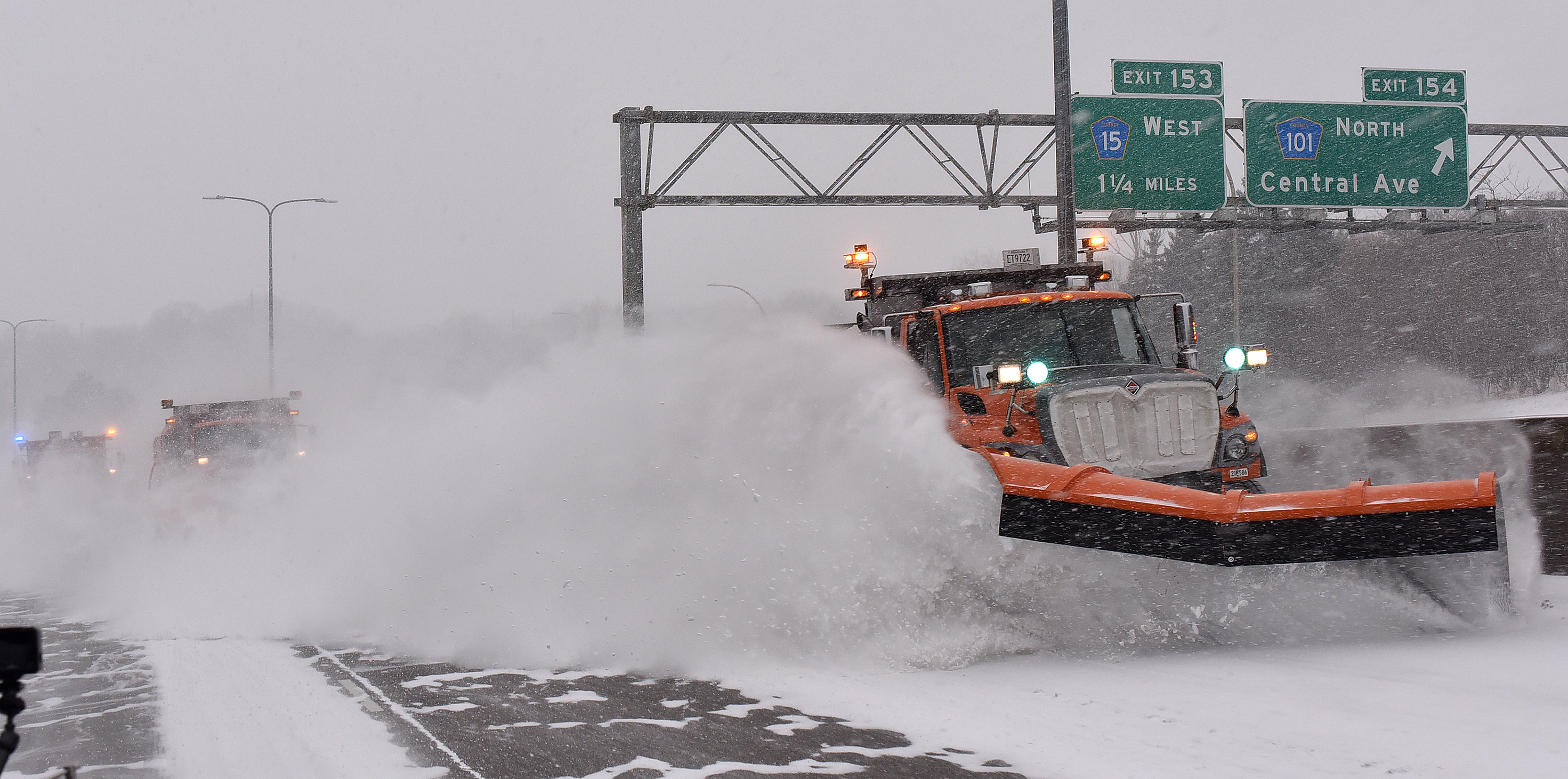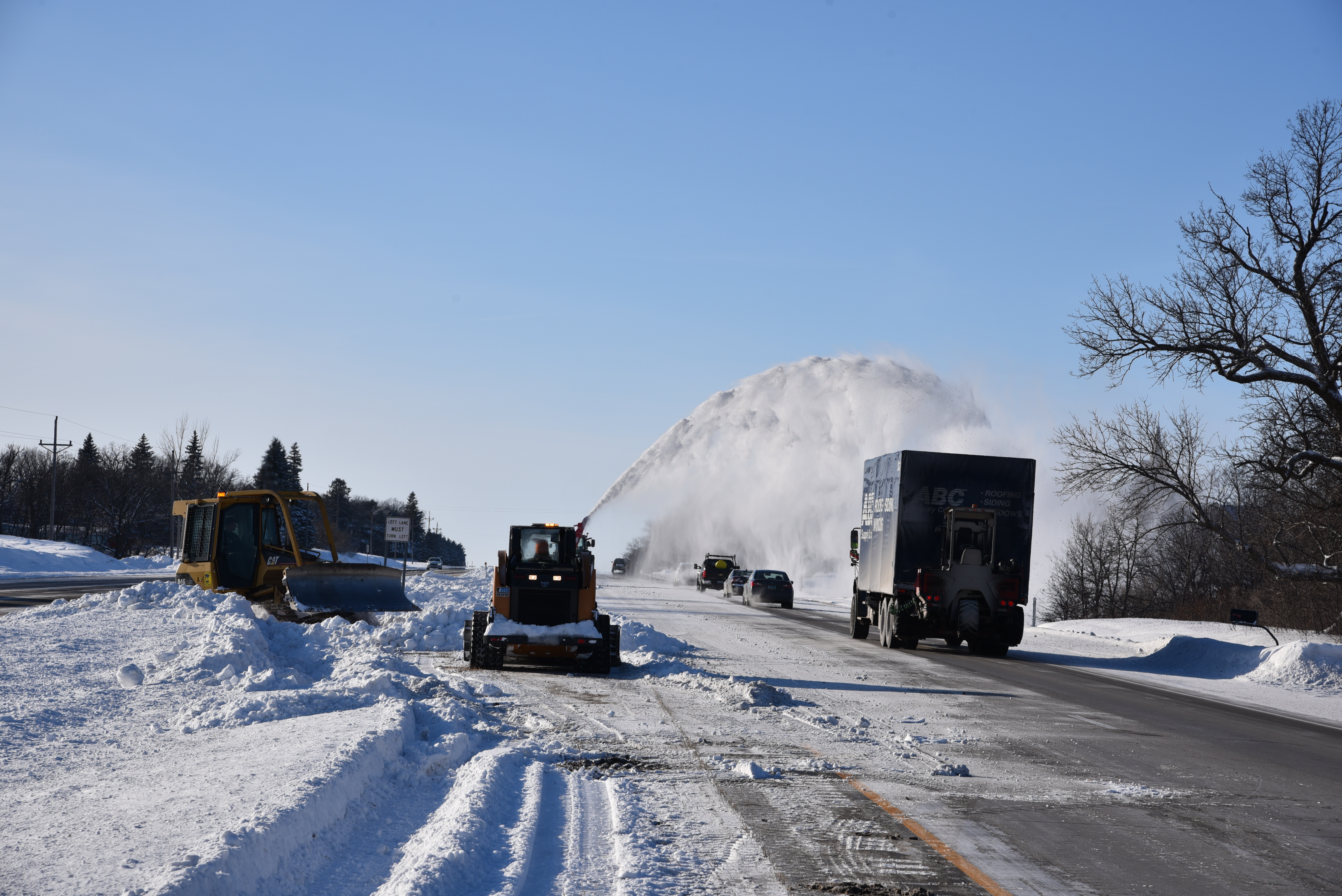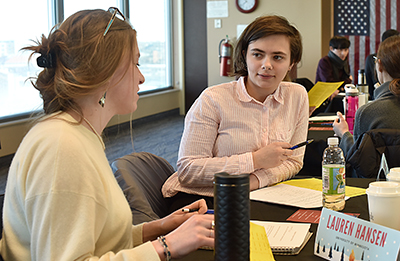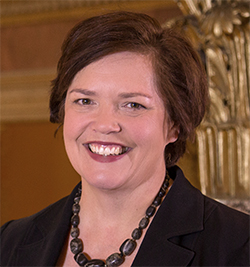 |
|

|
 |
TABLE of CONTENTS
|
Crews clear fourth round of snow in a week |
By Anne Meyer

These plows cleared parts of Hwy 12 in Wayzata as the snow started to fall on Friday, Jan. 17. Photo by Rich Kemp |

Crews in District 4 did prep work before the storm, clearing out medians on Thursday, Jan. 16, and pushing back drifts to make more snow storage space. They also worked with local farmers/landowners on Hwy 210 near Fergus Falls, who gave MnDOT crews permission to create temporary snow fences on their land using existing snow on the ground. Photo by Bryan Christensen |
MnDOT crews in each corner of the state worked through the Jan. 17-18 weekend to battle the fourth round of snow in one week.
The weather event was one of the biggest snow storms the state has seen all season. While snow totals were less than forecasted, highways in the northeast received more than a foot of new snow with this storm. Areas around the Twin Cities metro got anywhere from 3-7 inches of snow from the storm.
Bitter cold temperatures and strong winds followed the storm, which added a few challenges to clean up efforts. By Monday, most Minnesota highways were back to clear conditions.
Check 511mn.org for current road conditions and camera views throughout the state.
|
 |
|

|
 |
TABLE of CONTENTS
 |
MnDOT awards $18 million for transportation economic development projects in five communities |
By Mary McFarland Brooks
MnDOT recently announced awards for five state highway projects that will help support growing industry and businesses, leverage private funding and improve the transportation system for all users.
The five projects will receive a total of $18 million as part of the state’s Transportation Economic Development Program. The Department of Employment and Economic Development has also awarded $2.86 million for three additional projects in Mankato, Sherburne County and Minneapolis.
“The Transportation Economic Development program is an effective collaboration between state and local units of government to help deliver infrastructure improvements that enhance business growth opportunities around Minnesota,” said Commissioner Margaret Anderson Kelliher. “These transportation partnerships help build networks and promote job creation in our communities.”
This year’s TED funds help leverage federal, state, local and private funding for a total construction program of $124 million.
Twin Cities Metro Area
- Washington County: The interchange at Hwy 36 and Manning Avenue will improve access to planned development in the area, which includes a future Lakeview Hospital complex, a grocery store and other business development. The project is expected to help create 360 new jobs within five years.
- City of Chaska: The Hwy 41 reconstruction project in downtown Chaska will address current four-lane roadway issues by adding turn lanes and on-street parking for safer driving conditions.
- City of Dayton: Construction of the Dayton Parkway Interchange on Interstate 94 in the northwest Twin Cities metro area is anticipated to start in 2020 and will help create 100 new jobs in the next five years.
- Scott County: A grade separated interchange, additional frontage roads and accompanying access ramps along Hwy 13 will be constructed within the vicinity of Dakota and Yosemite avenues in Savage. The interchange is adjacent to the Ports of Savage, a key intermodal hub for transporting grain, commodities and other commercial products from southwestern Minnesota to the rest of the world.
Greater Minnesota
- City of Cloquet: A reduced conflict intersection is being constructed on Hwy 33 and Gillette Road in Cloquet and will be completed May 2022.
A total of $20 million was available for projects in this round of the TED program. MnDOT anticipates soliciting additional projects in Greater Minnesota in 2020 for the remaining funds.
A previous TED project, which received funding in 2015, was opened to traffic in November 2019 at the intersection of Hwy 36 and Hadley Avenue in Oakdale. Project improvements included a new bridge, interchange ramps, pedestrian improvements and the Gateway Trail underpass. The improvements resulted in reduced travel delays and improved safety for people driving, walking and bicycling in the area. There will also be a reduction in emergency response time for the Oakdale fire station, which is located near the new interchange.
The TED program was established in 2010. DEED administers a parallel program that funds projects on local roads and for other types of transportation. Projects may combine funding from both programs.
More information about the selected projects and the TED program.
|
 |
|

|
 |
TABLE of CONTENTS
 |
Fuel card use policy update aims to enhance procedures, control |
By Joseph Palmersheim MnDOT’s fuel card use policy has been updated for the first time in more than a decade.
The revised policy:
- Requires fuel card users to obtain an original receipt for fuel card transactions and provide it to the district/office fuel card coordinator.
- Assigns responsibility for coordinating the collection of fuel card transaction receipts and the reconciliation and storage process for fuel card receipts to the district/office fuel card coordinator.
- Assigns responsibility for retaining receipts pursuant to the Records Retention Schedule to the district/office fuel card coordinator.
- Establishes a deadline of the end of the next pay period for fuel card users to turn in receipts to the district/office fuel card coordinator.
“With the policy now in effect, it is important for every employee to review and understand how it impacts them,” said Steven Lund, director, Office of Maintenance. “We expect to see enhanced procedures, improved controls and full employee awareness as a result of the changes.”
One important change involves the completion of a policy review acknowledgment form. This step is required by the Department of Administration and is laid out in MnDOT’s policy and procedures documents. New employees will receive the form as part of their onboarding process. The form requires employees to sign off that they have read and understand the policy. Signed forms are then sent to the MnDOT fleet section, which will initiate the process of creating an Assigned Driver ID. The forms are also sent to the employee’s respective HR for retention.
The acknowledgment form can also be obtained from the fleet section. A signoff process for existing employee is still being worked out, Lund said.
The MnDOT Office of Audit conducted a performance audit of Central Office’s Business Service process in May 2018. This led to revision of MnDOT’s Fuel Card policy. The updated fuel card use policy addresses the findings and concerns related to fuel cards. A process and procedures document was also developed to help employees better understand the requirements of the policy update.
|
 |
|

|
 |
TABLE of CONTENTS
 |
Staffing updates |
By Joseph Palmersheim

Jed Falgren. Photo by Rich Kemp |
Jed Falgren has been appointed director of MnDOT’s new Transportation System Management and Operations Office. He started the new position Jan. 22. Prior to his appointment, Falgren was on a mobility assignment as the state maintenance engineer.
TSMO is an operational strategy designed to make a transportation system work better by managing disruptions. These include work zones, incidents, weather and special events. TSMO also seeks to manage improvements, including signal timing, freeway management and communication.
“While MnDOT is already a leader in this area, our citizens will see increased safety, efficiency and reliability benefits when we apply TSMO in a more proactive, consistent and deliberate manner across the state,” said Amr Jabr, assistant Engineering Services Division director. “Jed will report to the Operations Division and work across the organization with districts and several specialty offices to achieve these goals.”
Falgren received his bachelor’s degree in civil engineering from North Dakota State University. He served in many different roles since joining the agency in 1989, including as construction project engineer, maintenance operations and maintenance engineer in District 7. Falgren worked outside the agency from 1995 to 2010.

Ken Johnson. Photo by Rich Kemp |
Ken Johnson has been promoted to assistant traffic engineer in the Office of Traffic Engineering. He will provide leadership and direction to the Work Zone/Pavement Marking and Traffic Safety sections of OTE.
Johnson has worked for MnDOT since 1992, most recently as the State Work Zone and Pavement Marking engineer. During his career, he served in Traffic Engineering, Land Management and the Metro District.
He has a bachelor’s degree in civil engineering and a master’s degree in infrastructure systems engineering, both from the University of Minnesota.
|
 |
|

|
 |
TABLE of CONTENTS
 |
Newly funded research seeks transportation solutions |
By Micaela Resh, Office of Research & Innovation
Twenty-two new transportation research projects have been awarded funding. MnDOT’s academic research solicitation was highly competitive this year, receiving 82 proposals for projects ranging from pedestrian crossing safety to snowplow driver fatigue.
Researchers hope to tackle cutting-edge transportation questions, such as:
- Have Minnesota’s warmer winters increased the number of freeze-thaw cycles?
- Can transverse rumble strips improve safety at rural intersections?
- Are Minnesota’s pavement markings ready for automated vehicles?
- How do we best manage roadsides to serve as pollinator habitats?
- What methods can improve driver comprehension of flashing yellow arrows?
The MnDOT Research Steering Committee and the Minnesota Local Road Research Board solicit research ideas each spring from transportation practitioners and later request proposals from universities. The research governing boards meet in December to hear these proposals and select projects for funding. Research ideas for the upcoming funding cycle are currently being accepted.
Interested employees can serve on a technical advisory panel. Panel members play an essential role in the success of a research project by guiding the work and reviewing deliverables. Reach out to research.dot@state.mn.us to get connected (supervisor approval is required).
To stay in the know, employees can use the new “subscribe” option on the research project database. Subscribers will be notified via email when new resources are available.
Visit Ideascale to submit a research idea for the 2020 funding cycle.
|
 |
|

|
 |
TABLE of CONTENTS
 |
Seeds Winter Workshop brings future workforce together |
By Rich Kemp

Seeds students Lauren Hansen and Alexis Lipstein work on their negotiating skills during a class presented by Commissioner Margaret Anderson Kelliher Jan. 8. Photo by Rich Kemp |
The Seeds Program hosted a workshop Jan. 8 at the Veteran Services Building in St. Paul to bring Seeds students together for a day of training and collaboration.
The Seeds Program is a concept for MnDOT to grow its workforce talent. Its mission is to equip and train qualified, diverse students for potential permanent employment with the agency.
Commissioner Margaret Anderson Kelliher taught a class on negotiations. She went over some strategies in the negotiation process and had the students break into groups. Their task was to negotiate selling and buying a car, with goals they had to reach in the negotiating process.
“It was my first Seeds event,” said Erika Mejia, human resources intern. “I met a lot of people and liked the training by the commissioner. It was tough at first, but it was exciting to learn how to negotiate.”
The afternoon included training on peer-to-peer interviewing by Christine Fischer, HR special projects. She talked about the system that HR uses during interviews and then separated the students into partners to do mock interviews.
“I really enjoyed the workshop,” said Teng Lee, Central Office mobile technology. “The commissioner’s training was great and I learned some things about myself during the negotiations training and the mock interviews.”
More information about the Seeds Student Worker Program.
|
 |
|

|
 |
TABLE of CONTENTS
 |
On the Job: Wendy Surprise responds to data requests, works with tort claims |
By Joseph Palmersheim
Wendy Surprise works at Central Office as a data practices and tort claims coordinator. She says “Mondays are my favorite,” and finds inspiration working with people with integrity who want to do their best. The image below is linked to a larger version.

Do you or a co-worker have an interesting job to share with readers? Send us your ideas, and we’ll contact you for more information.
Recent employee profiles:
|
 |
|

|
 |
TABLE of CONTENTS
 |
Looking ahead to the opportunities in 2020 |
By Margaret Anderson Kelliher

Commissioner Margaret Anderson Kelliher |
A new year always brings with it a sense of reflection – on what happened in the year past, what opportunities lie before us in the present and what is to come in the year ahead.
As I think on the year past, I’m especially grateful for the opportunity to work alongside so many talented, thoughtful and hardworking professionals here at MnDOT. Since I became commissioner a little over a year ago, I’ve been consistently impressed with the dedication to improving the lives of Minnesotans that flows throughout this entire organization. I had the opportunity to travel across the state, meeting folks in all of our districts and hearing about what motivates them and why they enjoy working for MnDOT. And through my own health challenges last year, I was so appreciative of the outpouring of support. MnDOT is a special place because of the wonderful people who work here. Thank you for being one of them!
Looking ahead, there are many opportunities for us in 2020. From making progress on our sustainability goals and decarbonizing the transportation industry to exploring new and innovative technologies, I am excited about the advancements that MnDOT will make this year.
We’re also nearing the start of the 2020 legislative session. Last week, I joined Gov. Walz, Lt. Gov. Flanagan, and commissioners John Harrington (Department of Public Safety) and Myron Frans (Minnesota Management and Budget) to roll out the transportation and public safety portions of the administration’s Local Jobs and Projects Plan.
In total, the Walz-Flanagan administration is recommending a robust $451 million in transportation investments, including many of these requests submitted by MnDOT:
- $110 million for rail grade separation projects
- $112 million for the Local Bridge Replacement Program
- $100 million for the Local Road Improvement Program
- $10 million for the Greater Minnesota Transit Capital Program
- $19.2 million for three airport projects in Brainerd, International Falls, and Rochester
- $6 million for railroad crossing warning devices
- $8 million in General Obligation bonds and $2 million in General Fund cash for Safe Routes to School and to develop pedestrian safety projects on state reservations, respectively
- $58 million for the MnDOT Facilities Capital Improvement Program
- $5 million for the Minnesota Rail Service Improvement Program
- $10 million for a second daily passenger train between the Twin Cities, Milwaukee and Chicago
- $10 million for the Port Development Assistance Program
I’m looking forward to the 2020 legislative session and talking with our state lawmakers about the critical importance of investment in roads, bridges and our local communities. The Walz-Flanagan Local Jobs and Projects Plan would help us – and our local partners – make major strides in improving our transportation system statewide.
|
 |
|
| |
|



